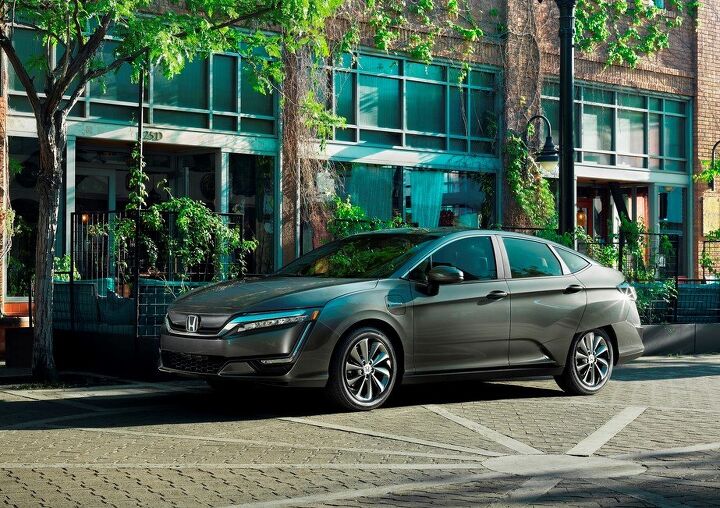As Honda's CEO Pours Cold Water Over Electrics, How Are the Brand's Dedicated Green Cars Doing?

Count Honda among the dwindling number of automakers that believe a sudden market shift to electric drive technology is little more than a pipe dream. As you read yesterday, the company’s CEO, Takahiro Hachigo, is on the record as saying, “I do not believe there will be a dramatic increase in demand for battery vehicles, and I believe this situation is true globally.”
While rival automakers like Toyota, Mazda, and Subaru have teamed up to advance their electrified ambitions, Honda chose to take it slow and go its own way. Its efforts have already born fruit, and continue to do so. Honda was the first automaker with a mass-market hybrid, but the ensuing two decades has seen the automaker temper its expectations of a fickle, gas-loving public. The brand’s product reflects its outlook.
So, how’s that product doing?
Well, we can’t tell you about the 2020 CR-V Hybrid, as that model only goes on sale early next year. Honda saw fit to keep a hybrid version of its new-for-2018 Accord sedan in order to challenge Toyota’s range of gas-electric Camrys, which shows a solid attempt to keep up with the segment leader.
As for dedicated green models, Honda hasn’t given up on the idea. To the contrary, last year saw the automaker stage a return of the Insight — a dedicated hybrid nameplate, only this time positioned as a semi-premium compact sedan between Civic and Accord. Arriving before the Insight was the Clarity — a seldom-seen line of green liftbacks boasting futuristic fender skirts and a trio of propulsion choices.
Offered (in California) as a fuel cell-powered electric vehicle, a plain battery-electric (in California and Oregon), and a plug-in hybrid (nationwide), the Clarity was a clear sign that Honda aimed to keep a toehold in the ultra-green field.
And a toehold it will remain, after Honda’s summertime decision to relegate its Clarity PHEV inventory to the state most likely to buy one: California. While dealers across the Lower 48 will still be able to order one, chances are you haven’t seen any sitting on lots recently. That move, plus the restricted horizons of the range-compromised BEV version and the hydrogen-quaffing FCV variant, has seen Clarity sales slip.
With the first few Clarity models arriving in December 2016, sales rose slowly through 2017 and came into their own in 2018, as wider availability brought the unique model to more driveways. Customers can only lease the FCV and BEV versions, and the fully-electric model offers just 89 miles of range. To counter the limited range, Honda offers a pretty cheap lease ($199 a month with $1,799 due at signing).
Clearly, the PHEV version is the most practical and widespread version, but Honda’s decision to focus more intensely on California has helped accelerate a downward sales trend. Only January and February of this year saw a year-over-year sales increase; each month thereafter saw Clarity sales slip. Clarity sales fell 70 percent, year over year, in October. September’s YoY decline was 75 percent. Year to date, the nameplate is down over 35 percent.
The Insight, however, is a newer and more easily attainable vehicle, and it isn’t nearly as scary to consumers, technology-wise. First appearing on the U.S. sales charts in June 2018, the Insight has averaged over 2,000 sales per month, though it seems the model quickly reached a sales plateau. On offer for just over a year, October and September saw the model suffer year-over-year sales decreases. Last month’s drop was to the tune of 25 percent.
One mark against the Insight is that, well, it’s a sedan. Not its fault. Another is that past Insights did not carry the same clout as the model’s rival, the Toyota Prius. The first iteration offered seating for two; the last, a feeling of lacklustre quality, despite the backseat. There were gaps where the nameplate disappeared altogether, sinking name recognition.
Where Honda takes its cautious, less-than-enthusiastic electrified product plan in North America remains to be seen. A global EV architecture is under development, capable of handling larger electric vehicles for markets like Europe, China, and the U.S. For now, hybrid variants of top-selling models, a la Toyota, seems the most sensible and cost-efficient way to insert green into its lineup.
[Images: Honda]

More by Steph Willems
Latest Car Reviews
Read moreLatest Product Reviews
Read moreRecent Comments
- TheEndlessEnigma Poor planning here, dropping a Vinfast dealer in Pensacola FL is just not going to work. I love Pensacola and that part of the Gulf Coast, but that area is by no means an EV adoption demographic.
- Keith Most of the stanced VAGS with roof racks are nuisance drivers in my area. Very likely this one's been driven hard. And that silly roof rack is extra $'s, likely at full retail lol. Reminds me of the guys back in the late 20th century would put in their ads that the installed aftermarket stereo would be a negotiated extra. Were they going to go find and reinstall that old Delco if you didn't want the Kraco/Jenson set up they hacked in?
- MaintenanceCosts Poorly packaged, oddly proportioned small CUV with an unrefined hybrid powertrain and a luxury-market price? Who wouldn't want it?
- MaintenanceCosts Who knows whether it rides or handles acceptably or whether it chews up a set of tires in 5000 miles, but we definitely know it has a "mature stance."Sounds like JUST the kind of previous owner you'd want…
- 28-Cars-Later Nissan will be very fortunate to not be in the Japanese equivalent of Chapter 11 reorganization over the next 36 months, "getting rolling" is a luxury (also, I see what you did there).





































Comments
Join the conversation
> Clarity — a seldom-seen line of green liftbacks boasting futuristic fender skirts and a trio of propulsion choices. Clarity is a sedan, not a liftback.
Hypothesis: There is negative correlation between the introduction of fender skirts and corporate longevity.